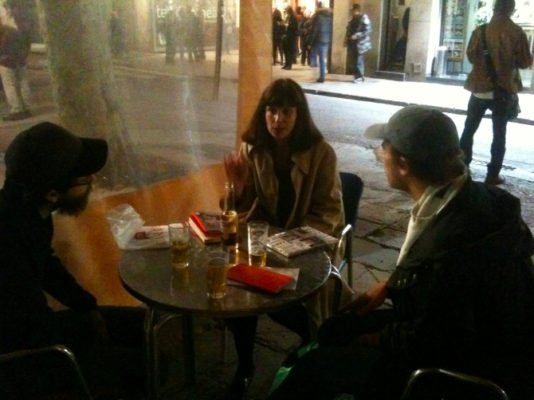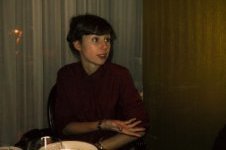Search
To search for an exact match, type the word or phrase you want in quotation marks.
A*DESK has been offering since 2002 contents about criticism and contemporary art. A*DESK has become consolidated thanks to all those who have believed in the project, all those who have followed us, debating, participating and collaborating. Many people have collaborated with A*DESK, and continue to do so. Their efforts, knowledge and belief in the project are what make it grow internationally. At A*DESK we have also generated work for over one hundred professionals in culture, from small collaborations with reviews and classes, to more prolonged and intense collaborations.
At A*DESK we believe in the need for free and universal access to culture and knowledge. We want to carry on being independent, remaining open to more ideas and opinions. If you believe in A*DESK, we need your backing to be able to continue. You can now participate in the project by supporting it. You can choose how much you want to contribute to the project.
You can decide how much you want to bring to the project.

In 2009, the Swedish artist Carl Palm stole some furniture from the University of Fine Arts in Stockholm. He constructed with his own hands the most exact replicas possible of chairs, tables and other bits of furniture, to later return them to the university. He then did the same in the gallery Invaliden 1 (Berlin, 2012), Komplot (Brussels, 2012) and IASPIS (Stockholm, 2010), being invited in the latter specifically to carry out this gesture. For the first time, in the exhibition “Síndrome” curated by Martí Manen, he is exhibiting these stolen pieces as his own private collection. The project that began calling itself “replaced & replaced”, has become ever more complicated, fruit of the characteristics of each intervention, until it has become “& REPPPPPPPPPPPPPPPPPLACED (AS IT WERE)”, the 17 letters alluding to the 17 new pieces of furniture that form the current collection.
In 2010, during a residency in England, Gabriel Pericàs stole a broom and painted it, as if it was a piece by André Cadere, later loaning it to the university (“Broomstick Pretending to Be a Round Bar of Wood by André Cadere or Stolen Object Returned as a Story”). In 2012, he made “Madera curvada”, a performatic derive based on a rocking chair by Thonet, situated in the house of his ex-girlfriend, that traced a journey from the origin of the techniques for producing curved wood, through to the tubular furniture of Marcel Breuer and other ins and outs of great figures of modern design.
Pericàs is a narrator, astoryteller. His figure is situated on the first plane, a certain rhythm in his voice accompanying the narratives, that more than performances are talks or narrative monologues that unite one object with another. The story to which they gravitate is the main element, whether it is a real story or a fiction is not important. This is also the reason why the publication acquires a fundamental role, the text and images of the objects constituting a register that continues the story.
In contrast Carl Palm wants his gesture to pass unnoticed. The pieces of furniture are situated in the space without any explanatory text, in an endeavour to achieve the maximum conceptual reduction. It is difficult to escape the clichés that cling to Scandinavian design and its complex history by forming part of an exhibition of Swedish artists. We don’t know if it is about privileging the visitor who knows the story behind the works or if the intention is simply to carry all the readings to the same level, be it visual or imaginative, theoretical or anecdotal.
Could it be that artists talk too much? Can the objects speak for themselves? These two lines of work explore the canonical ways of approaching the object. Through excess or absence, they wear down interpretation. A domestic element acquires new registers, reducing it to the most basic level of the gaze or suggesting infinite narratives through the voice and fiction.
The standard form of all rational knowledge is based on the epistemological paradigm of knowledge where things are explained by way of correctly formulated and deduced causes. The fact of wanting to alter this equation in art is not new. The enigma of interpretation has pursued us since “Ceci n’est pas une pipe” by Magritte and Duchamp’s urinal. But it is not so common in other fields like science or design.
The standard form of all rational knowledge is based on the epistemological paradigm of knowledge where things find their explanations in their correctly formulated and deduced causes. The fact of wanting to alter this equation in art is not new. The enigma of interpretation has pursued us since “Ceci n’est pas une pipe” by Magritte and Duchamp’s urinal. But it is not so common in other fields like science or design.
For dOCUMENTA (13), Raimundas Malašauskas carried out the project “Black Box”, a series of conversations about objects in the Cabinet of Astronomy and Physics of the Orangerie museum, the meaning and use had been lost with the passing of time, converting them into abstract and unclassifiable objects. Once a week, different artists, philosophers and scientists met up to speculate, in homage to the hypothetical relativity of knowledge. What they were looking for were stories, to create, through imagination and fantasy, alternative forms of understanding.
In a similar way, Carl Palm experiments with different ways of perceiving the objects through daydreaming and meditation, in what he calls “Nocturnal Studios”. “Ceci n’est pas un brioche” is a curtain that converts into an exhibition space, where the objects imagined by the artist during his nocturnal deliriums can be embroidered. Pericàs uses techniques that stem from narrative and persuasion to over-direct the spectator through rhetoric and fiction. Chance and contingency are often the triggers that initiate the stories, which can arise from the design of an object, an occasional accident, or an anecdotal episode and which transport you to a state of total passivity (almost hypnotic) through the seduction of speech.
The domestic object, charged with familiarity, becomes a place where we decide to reunite some disparate things, where we endeavour to establish multiple, imaginative relations, an area that possesses its own rules, linking things that aren’t evidently linked. In this way the diverse, sensitive and diffuse character of words, and above all imagination, is introduced. This has nothing to do with a personal or gratuitous fantasy but confers an oblique understanding, accepting the multiple. Even finding amusement in it.
Síndrome Encontres
Within the framework of the exhibition project “Síndrome” in La Capella a series of encounters, without an audience, are being organised amongst the artists present in the exhibition with artists active in Barcelona and other cultural agents. Conversations, of around three and half hours, that are in the end chronicled in a text. These texts are published on the platforms A*DESK, Arts Coming, Esnorquel and Oficina36.

Rosa Lleó has been a publisher. From her years in England she has kept the short sentences and vinyl records. Now she writes and occasionally makes exhibitions.
"A desk is a dangerous place from which to watch the world" (John Le Carré)